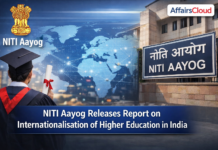
On November 30, 2021, the Ministry of Social Justice and Empowerment announced the formation of a 3-member committee to review the annual income criteria for Economically Weaker Section (EWS) reservations in job and central education institutes.
About the Committee:
i.The 3 members of the Committee:
- Ajay Bhushan Pandey – Former Finance Secretary
- Prof VK Malhotra – Member Secretary, ICSSR (Indian Council of Social Science Research)
- Sanjeev Sanyal – Principal Economic Advisor to the Indian government (Member Convenor).
ii.The committee will now review the Rs 8 lakh family annual income ceiling for EWS to apply for 10 percent reserved seats in central education institutes and government jobs.
iii.The committee will examine various approaches followed in India so far for identifying EWS and recommend criteria regarding that.
About EWS:
i.The 10 percent EWS quota was introduced under the 103rd Constitution (Amendment) Act, 2019.
ii.The 10 percent EWS reservation is given only for the General Category candidates apart from other category reservation benefits of OBC (27%), SC (Scheduled Castes) (15%), and ST ( Scheduled Tribe) (7.5%).
iii.Income Norms for EWS:
- The person who is not covered under reservation for SCs, STs and OBCs and whose family has a gross annual income below Rs 8 lakh could avail EWSs reservation.
- Those who owned 5 acres of agricultural land and above, residential flat of 1,000 sq ft and above, residential plot of 100 sq yds and above in notified municipalities and residential plot of 200 sq yds and above in areas other than notified municipalities are not eligible to avail the EWS benefit.
Cause for Committee formation:
i.Some NEET (National Eligibility cum Entrance Test) candidates had challenged a government notification setting aside 27 percent quotas for OBCs and 10 percent for EWS in the All India Quota (AIQ). Click here to know more
ii.On October 25, 2021 the Supreme court had directed the Centre to put on hold counselling for NEET-PG(PostGraduate) until it decided the validity of OBC and EWS reservation in the AIQ.
iii.As the annual income limit for both inclusion under EWS and exclusion of OBC creamy layer lies same at Rs 8 lakh, the Supreme court questions about on what basis the annual income limit for both OBCs creamy layer (which was socio-educational backwardness based) and EWS (which was purely economic based) are fixed at same.
About Creamy Layer of OBC:
i.The ‘creamy layer’ concept was introduced in the Supreme Court’s Indra Sawhney judgment on November 16, 1992.
ii.Currently, persons with annual family income above Rs 8 lakh are considered under the ‘creamy layer’ and they are excluded from reservation benefits of job and education reservations that are given to OBCs.
iii.The hike in income of Rs 8 lakh for classifying Creamy layer in OBC was set in 2017, and the previous threshold was Rs 6 lakh set in 2013.
- The Centre should have increased the threshold by September 2020 as it must be revised every 3 years.
iv.Based on the Mandal Commission’s report to give 27 percent reservation to OBC, the court found it necessary to identify sections of backward classes who were already highly advanced socially as well as economically and educationally.
- The court directed the State governments to identify the ‘creamy layer’ and exclude them from the purview of reservation.
Recent Related News:
The Ministry of Health & Family Welfare (MoHFW) announced 27% Reservation for OBCs (Other Backward Classes) & 10% Reservation for EWS (Economically Weaker Section) in the All-India Quota Scheme (AIQ).
About Ministry of Social Justice and Empowerment:
Union Minister – Virendra Kumar (Constituency – Tikamgarh, Madhya Pradesh)
Minister of State – Ramdas Athawale (Constituency – Maharashtra), Pratima Bhoumik (Constituency -Tripura West, Tripura), A. Narayanaswamy (Constituency – Chitradurga, Karnataka)




